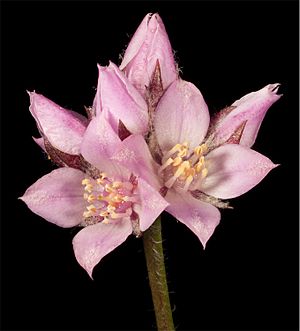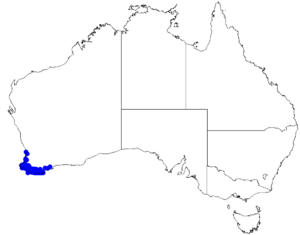Boronia juncea facts for kids
Quick facts for kids Boronia juncea |
|
|---|---|
 |
|
| B. juncea in the Lake Muir Nature Reserve | |
| Scientific classification | |
 |
|
| Occurrence data from Australasian Virtual Herbarium |
Boronia juncea is a special plant that belongs to the citrus family, called Rutaceae. It's found only in the far south-west part of Western Australia. This plant is a tall shrub with thin leaves that don't last very long. It grows groups of up to eight pretty white to pink flowers, each with four petals.
What Does It Look Like?
Boronia juncea is a straight-growing shrub. It can reach a height of about 20 to 80 centimeters (8 to 31 inches). Its leaves don't stay on the plant for a long time.
The lower leaves are long and narrow, about 20 to 40 millimeters (0.8 to 1.6 inches) long. The leaves higher up are more round, like a cylinder, and are about 10 to 40 millimeters (0.4 to 1.6 inches) long.
This plant produces groups of three to eight flowers. These flowers can be pink or white. Each flower sits on a thin stalk called a pedicel, which is about 10 to 50 millimeters (0.4 to 2 inches) long.
Each flower has four dark red, triangle-shaped parts called sepals. These sepals are about 1.5 to 5 millimeters (0.06 to 0.2 inches) long. The four petals are usually 3 to 8 millimeters (0.1 to 0.3 inches) long. Inside the flower, there are eight stamens, which are smooth and don't have hairs.
You can usually see Boronia juncea flowering from October to December. Sometimes, it flowers later, from January to April.
How It Got Its Name
The plant Boronia juncea was first officially described in 1845. A scientist named Friedrich Gottlieb Bartling gave it its name. He published his description in a book called Plantae Preissianae.
The second part of its name, juncea, comes from a Latin word. It means "of rushes". This name probably describes how the plant looks, perhaps like rush plants.
Where It Grows
Boronia juncea likes to grow in areas that get wet during winter. Different types of Boronia juncea grow in specific places.
For example, one type, called subspecies juncea, is found between Bunbury and Mandurah. Other types, subspecies laniflora and micrantha, grow near Mount Melville and Mount Elphinstone in Albany. The subspecies minima is found between Margaret River, Augusta, and Northcliffe.
Is It Protected?
The Western Australian Government's Department of Parks and Wildlife has looked at Boronia juncea. They have classified it as "not threatened". This means the plant is not currently in danger of disappearing.

